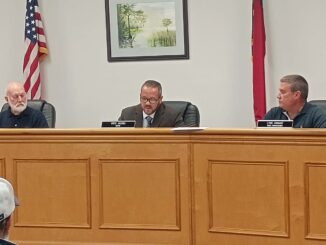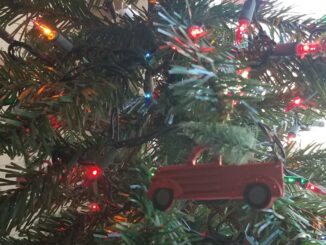
On the road the other day, I glanced at an old farm I’ve watched for years, but this time there was nothing left to see.
The first house on the farm was built sometime before the War Between the States. The farmer came home to his wife and one or two children, struggled with everyone else through Reconstruction, and managed to make a living. The first home was incorporated into a packhouse when tobacco became king, and the growing family built another home a short walk across what was undoubtedly a well-swept yard. It was three, maybe four rooms, with a couple more added on along the way.
Sometime around the turn of the 20th century, another home was built a hundred feet away. It too was humble. One of the grown children opted to stay home and raise his own family on the farm. His sister had married and moved to town. No one seemed to know what happened to the third child, another son.
The original farmer and his wife lived on in the home that they built. The farmer passed away sometime around World War I, and his wife held on until the 1930s. She sat on the porch, tended her chickens, planted a garden, never missed church and cooked big Sunday dinners.
A child of the third generation on the land eventually moved into his grandparents’ home. He farmed beside his daddy. When the Second World War called him to duty, he left his wife in what had been his grandmother’s house and went to fight. On his return, he got a job in town, and moved his family there. His parents still worked the land, transitioning from mules to a tractor to a larger tractor. Eventually, they too, went on to their final rewards. The farm was leased, the barn fell into disrepair, and the old houses rented for a few years, then used for storage.
When I visited the farm years ago, back before copper thieves and vandals led to the erection of posted signs and chained gates, the corn crib was leaning to one side. Like most old barns, the wooden trough showed signs of being gnawed by bored livestock. A pile of rubble showed where the original mistress had nurtured her chickens, dealing with possums, snakes, foxes, coons and stray cats. There were the usual dependencies whose purposes were now forgotten, but at one point in time were deemed worthy of handsawed boards and nails and an afternoon’s work, maybe even a half-dollar’s worth of paint and a half a sheet of roofing tin. There were three or four stone and brick foundations showing the ghosts of tobacco barns.
The houses were securely locked, so I had to be satisfied with looking through the windows, a peeping tom whose motivations were purely historical, a purely archaeological voyeur. Inside were boxes, odd pieces of furniture, and the usual ephemera left behind by lifetimes. Vines, devil-root, dog fennel and other noxious flora were steadily reclaiming the land and the homes.
For years I knew nothing of the family who lived there, until a chance conversation opened a door to a little more about them. A relative of a relative was trying to find someone else, and as is often the case with family histories, he ran down the rabbit hole of his own kinfolk’s neighbors.
There was nothing unusual about the farmers or the farm – no scandals, no brilliant inventions. No fortunes made or lost. No war heroes. No rumors of bootleg liquor sold in Mason jars by the dark of the moon. No children of questionable parentage. They were faithful church members for several generations, all attending the same church a few miles down the road. There were a few children who never made it to adulthood alongside the first family in a forgotten family graveyard near the back of the property, but sadly that wasn’t unusual for the time.
Just ordinary, hardworking, honest farmers, the kind of folks who were woven together to create the warp and weft of the fabric of our country, at a time when a few dozen, then a few hundred acres could support the husband, wife, some young’uns and an aged parent, as long as there wasn’t too much rain or it was too dry, and the hogs didn’t get sick and the cows stayed healthy. They managed to own their own land, and make a living off of it, until the definition of making a good living was changed, and manicured grass around a sturdy brick home replaced a well-swept dirt yard in front of a shotgun house as the new ideal.
On my brief visit that day, I didn’t even pick up a rusted nail as a souvenir. I figured to track down the owners and ask permission. Most times folks allow me to wander and plunder at will, since I try to be a good guest and anything of real or sentimental value gets turned over to the family if they wish.
But time got away. We moved, and I no longer drove past the old farm on a daily, or even a monthly basis. I took notice when one of the landmark oaks was split by a storm, and then the inevitable chinaberry tree was knocked down during a hurricane. That same hurricane caused the leaning corncrib to give up the fight. The barn just gave up the ghost and kind of fell backwards, likely crushing the remains of the original home.
Back last year, I noticed an excavator parked beside the pile that had been a barn. A month or so later, the all-consuming vines had been forced into submission. Someone was doing something with the older of the two homes, but you can only see so much at 55 miles per hour in holiday traffic. I held out hopes that maybe someone was going to restore at least one of the homes, since even the stylized version of country-cutesy restoration is preservation of a sort, as opposed to a burn scar in a bare field crowned with a mobile home.
Sadly, that was not the case.
When we drove past the old farm the other day, the entire property had been cleared down to the bare dirt.
The shading oaks were gone, as were both family homes. There were no strands of rusted barbed wire extending toward a forgotten hog pen. The chicken coop was long gone, of course, as was the corn crib, but the ground as embarrassingly empty, save for a few piles of broken tree trunk, limbs and most likely, riven shingles, siding and roughcut fat lighter beams and joists pushed into a spot where they could be safely burned.
I have likely related too many such stories of forgotten old farms to you, my faithful readers. I appreciate your forbearance.
But whenever I pass an old store, an old home, and old farm, I can’t help but think of those who walked the ground before, those who saw a spot and decided to build a life there, who dealt with challenges and losses and victories and joys and sorrows and still carried on, fighting battles many of us can’t understand, battles which were fought so future generations could have a better life – folks who gave so much, and now are nothing but names on thorn-covered headstones behind a farm where there’s nothing left to see.






















